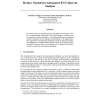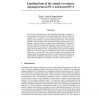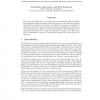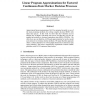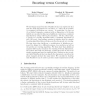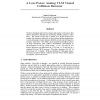NIPS
2003
15 years 2 months ago
2003
We describe a procedure which finds a hierarchical clustering by hillclimbing. The cost function we use is a hierarchical extension of the -means cost; our local moves are tree...
134
Voted
NIPS
2003
15 years 2 months ago
2003
We examine the use of hidden Markov and hidden semi-Markov models for automatically segmenting an electrocardiogram waveform into its constituent waveform features. An undecimated...
NIPS
2003
15 years 2 months ago
2003
We derive the limiting form of the eigenvalue spectrum for sample covariance matrices produced from non-isotropic data. For the analysis of standard PCA we study the case where th...
100
Voted
NIPS
2003
15 years 2 months ago
2003
In models that define probabilities via energies, maximum likelihood learning typically involves using Markov Chain Monte Carlo to sample from the model’s distribution. If the ...
116
click to vote
NIPS
2003
15 years 2 months ago
2003
We discuss the integration of the expectation-maximization (EM) algorithm for maximum likelihood learning of Bayesian networks with belief propagation algorithms for approximate i...
82
Voted
NIPS
2003
15 years 2 months ago
2003
A mobile robot acting in the world is faced with a large amount of sensory data and uncertainty in its action outcomes. Indeed, almost all interesting sequential decision-making d...
103
Voted
NIPS
2003
15 years 2 months ago
2003
Approximate linear programming (ALP) has emerged recently as one of the most promising methods for solving complex factored MDPs with finite state spaces. In this work we show th...
99
Voted
NIPS
2003
15 years 2 months ago
2003
We investigate improvements of AdaBoost that can exploit the fact that the weak hypotheses are one-sided, i.e. either all its positive (or negative) predictions are correct. In pa...
104
click to vote
NIPS
2003
15 years 2 months ago
2003
We have designed and tested a single-chip analog VLSI sensor that detects imminent collisions by measuring radially expansive optic flow. The design of the chip is based on a mode...
NIPS
2003
15 years 2 months ago
2003
When clustering a dataset, the right number k of clusters to use is often not obvious, and choosing k automatically is a hard algorithmic problem. In this paper we present an impr...

